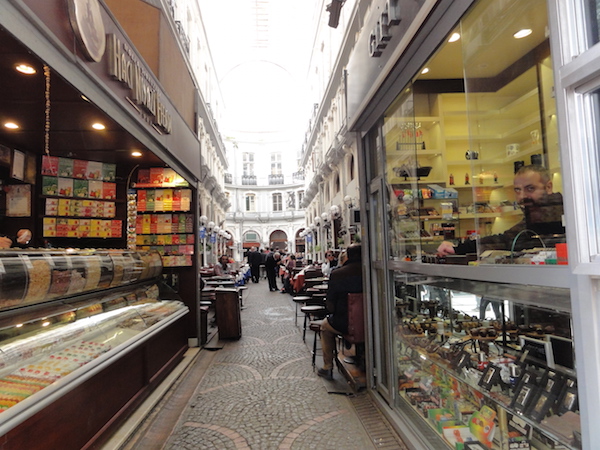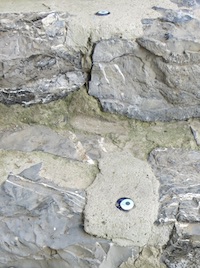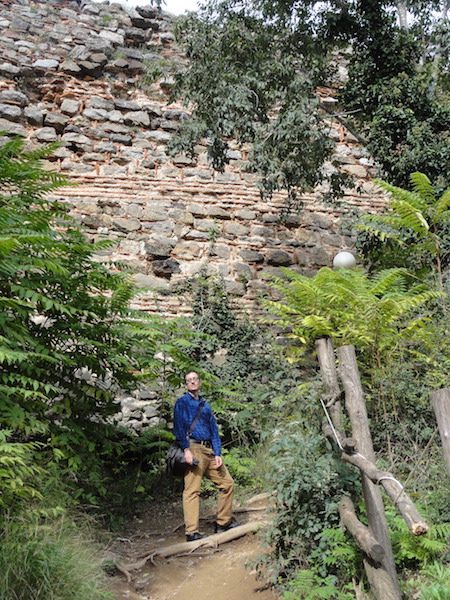Continued from Part 4. Series begins with Part 1.

With the recent news of yet another terrorist attack in Turkey, I offer a new installment in my travelogue of a visit last fall to the increasingly troubled country. Its wonderful people seem trapped in a tightening vise between murderous extremists and an increasingly despotic government.
In these times it’s worth remembering the ideals and accomplishments of the founder of modern Turkey, Mustafa Kemal Atatürk, a stern secularist and modernizer whose legacy persists in many ways, not least the country’s ongoing push to join the European Union despite the EU’s own increasingly disunited condition.
When Atatürk died in 1938, he was at home in the Dolmabahçe Palace, his summer residence and formerly the final administrative center of the Ottoman Empire. Turkey’s biggest palace was built in the mid-1800s on the western (European) side of the Bosphorus, the storied waterway that splits Istanbul in two and divides Europe from Asia.


It’s a bit of a distance from Sultanahmet, so we took the train. It was a beautiful day by the Bosphorus. Our first impression of the palace was of something shiny and lovely. But the true scale of the place becomes apparent only when you walk around to the sides. It’s a testament to the grandeur of the Ottoman Empire’s self-image.

Look eastward and the Bosphorus gleams through the gates.

No photos are allowed on the cursory tours of the interior, conducted in huge groups. (Have a look at the Vikipedi (Turkish Wikipedia) article for some inside images, or just to immerse yourself in the Turkish language for a minute.) I remember most clearly the incredible furniture and chandeliers – some of them gifts from the likes of Queen Victoria – and Atatürk’s room, where he died.
Leaving the palace we headed inland and found our way to the big commercial center at Taksim Square, and the start of Istiklal Caddesi (Istiklal Street), one of the city’s major shopping districts. Thanks to the Nobel Prize winner Orhan Pamuk‘s memoirs, I had pictured the 19th-century Beyoğlu neighborhood in my mind before I was ever there.



Several large churches lie along Istiklal Street. We stopped into St. Anthony’s.

![]()
Two ancient synagogues are also noted on the tourist map along Istiklal. With difficulty, we managed to spot one of them, half-hidden behind storefronts. The Ahrida Synagogue was built by Greek Romaniotes Jews who had emigrated from Ohrid, in today’s Macedonia, and were later absorbed into the larger Sephardic Jewish population. The original early-15th-century building was damaged and possibly destroyed by a fire in the late 17th century, then rebuilt. According to TurkishJews.com (who knew?), “A remarkable feature of the Ahrida is its Teva (Bima) which is in the shape of the prow of a ship. The tradition says that it symbolizes either Noah’s Ark or the Ottoman ships which transported the Sephardim from Spain to Turkey. Its design is impressive and memorable.”
It seems you have to make special arrangements to visit Istanbul’s historic synagogues, so we didn’t see inside. But in fact we were glad just to have managed to spot it.

After reaching the southern end of Istiklal we wound our way through medieval streets to find the Romanesque Galata Tower (Galata Kulesi), built by the Genoese in 1348 as part of their Constantinople colony. Back then it didn’t have a restaurant inside, or elevators. Because of the latter, the extremely narrow observation deck is throttled with tourists squeezing past each other to circle the tower and snap pictures of the fabulous views of the great city.

It was a bit of a wait to get inside, but well worth it for the views of the city, the Golden Horn, and the Bosphorus. Our near-sunset timing was perfect too.



The tower had elevators. But the last leg of our walk to the waterfront included some actual legwork.

And then: The Golden Horn and the Galata Bridge.







A Turkish friend of ours in New York had connected us with a cousin and a friend of hers in Istanbul. We met them for dinner at the Akin Fish restaurant just off the edge of the Golden Horn. We’d probably never have chosen it on our own – it’s off the main drag down a broken-down side road that felt a little scary after dark, and once we got there it took us a while even to figure out where to go in. But eating fresh, simple seafood meze dishes and drinking raki with wonderful new friends in a lively garden by the water was the perfect end to a beautiful day.
Two days later, after a whirlwind one-day trip to Ephesus which I’ll describe in the next and final installment, we took a cruise up the Bosphorus to its northern mouth at the Black Sea. In nice weather, this is a great way to see the city from another vantage point and also get away from it for a bit. The boat makes stops at a few ports along the way, former villages now absorbed into greater Istanbul, where locals who use it as a ferry mingle with tourists snapping photos of places like the Dolmabahçe Palace, castles, villas, fishing boats, mosques (of course), and a great bridge, unfinished at the time of our passing.







The terminus is the touristy hillside town of Anadolu Kavaği, on the Asian side.

The boat dropped us off with enough time to eat lunch at one of the mediocre seaside restaurants that crowd the harbor – there’s not much else to see in the village itself besides a few gift shops – and then take a quick hike to the top of the hill, and Yoros Castle.
The town has a clearly marked and sternly fenced off military installation; on the other side of the Black Sea is Russia. It wasn’t long after our visit that a Russian jet was shot down by Turkish forces. A visit to this spot reminded me of how these two historically powerful entities and enemies face each other directly.
Yoros Castle overlooks the Bosphorus and, to the north, the Black Sea.

A UNESCO World Heritage site, Yoros Kalesi (Yoros Castle) is a Byzantine castle with a long history on a site with an even longer one. Wikipedia explains: “The remains of temples, including Dios, Altar of the Twelve Gods, and Zeus Ourios (Zeus, granter of fair winds) were discovered in the area, dating to centuries BCE.” As for the castle, “Byzantines, Genoese, and Ottomans fought over this strategic fortification for years.” It isn’t known, or at least it isn’t easy to find out, when the first foundations for the castle were laid.






I wondered why there was no information posted at the castle, no historical signs, no brochures down in the village. As it turns out, the knowledge is incomplete and the access very limited. The Hürriyet Daily News reported in 2010 that an archeological project at Yoros was actually breaking new ground – the Turkish military controls the site and hadn’t allowed excavation before then.
“The team has two big goals: One is to find a temple that is mentioned in ancient sources and the other is to determine when Greek colonies first arrived in the Black Sea…no scientific research has been done so far at the Yoros castle. ‘Forget about archaeological excavation, even its history has not been written,'” said Professor Asnu Bilban Yalçın. “The castle was named ‘Hieron’ (holy place) in the ancient times in Greek and Latin sources. There was once a temple dedicated to Zeus on the spot.”

Again according to Yalçın, “Research in the Black Sea coasts has so far been conducted in the Russian and Georgian parts only. No research has been conducted in the Turkish part. Therefore the Black Sea is a virgin area. All things that will be found there are very important. It may change western history to determine when the Greek colonies arrived in the Black Sea.” A follow-up article in 2013 reported that work was being resumed. Clearly, digging up more detail on the history of Yoros Castle is going to be a slow, halting process.
We arrived back in central Istanbul in the late afternoon, and being the nonstop sightseers we are, decided to get right back on another boat. The ferry to the Asian side took us to the neighborhood of Kadıköy, on the north coast of the Sea of Marmara. We were in search of a famous restaurant called Çiya Sofrasi.
In Kadıköy we got a sense of how vast a metropolis Istanbul is.

Packed with people and businesses, Kadıköy felt like a whole additional city. It was a little like crossing the East River from Manhattan to Brooklyn, only with what seemed even bigger masses of humanity. (And Manhattan and Brooklyn aren’t on separate continents!) I wish we’d taken more pictures. But I suppose that after a whole day of sightseeing our eyes were tired.

Even after dark, the market streets were crowded with goods and people. We were happy to find our way onto a quieter stretch to get our bearings and figure out how to find the restaurant.
In the words of Lonely Planet, “Known throughout the culinary world, Musa Dağdeviren’s lokanta (eatery serving ready-made food) showcases dishes from the region surrounding the chef/owner’s home city of Gaziantep and is a wonderful place to try Turkish regional specialities.”
Yes. The food at Çiya Sofrasi is very different from what we had gotten used to elsewhere in Istanbul and in Cappadocia. (Though the candied eggplant and other candied dessert items did call to mind the candied walnut-fruit – the whole fruit, with what we know as a walnut inside – at the Kelebek Cave Hotel‘s farm breakfast in Cappadocia.) It contributed to making our trip to Turkey one of the premiere culinary experiences of our life. Take note: there are a couple of Çiya Sofrasi rooms on the block. I’m referring to the casual, almost cafeteria-style location where you can see the ready-made dishes in a display on the right as you walk in.

The ferries don’t run all night, but we caught one of the last few back to the European side, then took the streetcar back to Sultanahmet and our room at the Angel’s Home Hotel.

Our last day in Istanbul had been quite special, and we were sad the trip was over. There’ll be one more installment in this travelogue, though, doubling back a day to describe our whirlwind day trip to the ancient city of Ephesus.
Concluded in Part 6: Ephesus
 Blogcritics The critical lens on today's culture & entertainment
Blogcritics The critical lens on today's culture & entertainment




I have really enjoyed this series, Jon. The photographs are amazing! Looking forward to the next installment.